ERIC SMISTAD, National Energy Technology Laboratory, U.S. Department of Energy
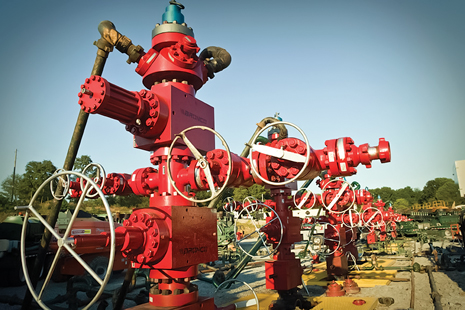 |
| Horizontal Marcellus shale gas wells (above) on a multi-well drill pad in southwestern Pennsylvania (photo courtesy of Range Resources-Appalachia). |
|
Only a few years ago, the price of natural gas was increasing rapidly, and many people were struggling to heat their homes. Since then, the price of natural gas has fallen, due to increased production from two non-traditional sources: coal beds and organic shales. Yet, effective production from unconventional gas resources requires well drilling and completion technologies that are too new for their environmental footprint to be well-established. The National Energy Technology Library (NETL) is conducting research to accurately assesses the impact of unconventional gas development on ecosystems, where gas plays are located, to provide impartial, scientific information. NETL is also actively developing cost-effective technologies and management strategies that aim to mitigate identified environmental impacts.
NETL researchers have used geophysicists to track saline water underground, and to improve the way that such water is treated and used at coalbed natural gas extraction sites in the western U.S. They have also recently demonstrated that the water produced in Wyoming’s Powder River basin can be used to water crops via subsurface irrigation. In the eastern U.S., NETL is leading a consortium, comprised of eight state and federal agencies, evaluating the environmental impact of shale gas production. Much of this research is briefly summarized below.
ENVIRONMENTAL STUDY—SUB-SURFACE DRIP IRRIGATION SITE
NETL and the U.S. Geological Survey (USGS) are collaborating with BeneTerra LLC to monitor a sub-surface drip irrigation (SDI) system, at a site in the Powder River basin (PRB) of Wyoming, Fig. 1. Irrigation water for the SDI system is co-produced with coalbed natural gas (CBNG). The study is being conducted at the Headgate Draw area, approximately 11 mi south of Arvada, Wyo., at the confluence of Crazy Woman Creek and the Powder River. The study site encompasses six alfalfa fields and covers an approximate area of one-half sq mi.
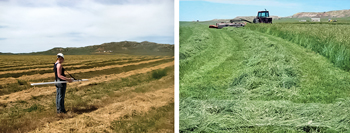 |
| Fig. 1. On the left, a researcher uses a geophysical tool to assess the effects of subsurface drip irrigation (SDI) on soil conductivity; on the right, alfalfa is harvested from land irrigated with produced water through SDI. |
|
The CBNG water is applied to the root zones of agricultural land. This style of irrigation can apply two to three times more water on a site than traditional surface irrigation. It is designed to minimize environmental impacts by parking potentially detrimental salts below the land surface, but above the water table. NETL is investigating the transport and fate of the water and salts from the injected CBNG produced water at the SDI site.
This study has shown that subsurface irrigation with CBNG produced water is an environmentally acceptable practice in the Powder River basin. The Ca- and Mg- minerals in the native soil dissolve in the applied CBNG produced water to maintain a sodium adsorption ratio that sustains soil permeability (the primary concern when using high-Na produced water for irrigation). Geochemical modeling, based on three years of soil mineralogy, soil chemistry, and groundwater chemistry data from the prospective study, indicates that CBNG produced water can be applied by sub-irrigation for about 10 years, at current application rates, before adverse impacts to soil permeability result. This study provided the Wyoming Department of Environmental Quality with the scientific basis to approve sub-surface irrigation for the management and beneficial use of CBNG produced water.
RESEARCH ON AIR QUALITY IMPACTS
The development of shale gas resources requires horizontal drilling and multi-stage hydraulic fracturing, two processes that result in more air emissions than conventional natural gas production. Horizontal drilling requires larger rigs, with more horsepower, that operate longer, to complete the long horizontal segments of shale wells. Similarly, hydraulic fracturing requires large volumes of water, often hauled to the wellsite by truck. More than 500 such trips are needed to transport enough water for the hydraulic fracturing of one well. The atmospheric emissions from trucks, combined with the emissions from multiple, diesel-powered, hydraulic fracturing pumps, can cause a short-lived, but significant, impact to local air quality. Atmospheric emissions from the venting of condensate tanks, dehydrators and pneumatic valves are additional, constant sources that persist as long as natural gas is being produced.
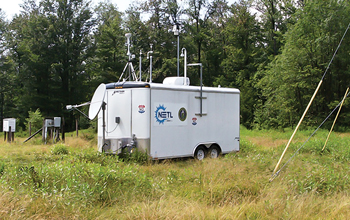 |
| Fig. 2. NETL’s mobile air monitoring laboratory, deployed in the Allegheny National Forest of northwestern Pennsylvania. |
|
NETL is leading several field studies to determine air quality impacts resulting from the development and production of gas resources in the Marcellus shale. A field monitoring trailer, that measures multiple atmospheric signals (e.g., ozone, particulates, organics and other gases), is being deployed at a range of sites, to document temporal atmospheric signals as a function of geography, season, operation, etc. The mobile air monitoring laboratory was deployed to the Allegheny National Forest (ANF), in north-central Pennsylvania, for approximately one year (July 2010–June 2011), Fig. 2. Historically, the forest has been a productive area for oil and gas wells, but the number of wells has increased significantly in the past few years, as Marcellus shale gas wells have been drilled. Ambient concentrations of constituents and other air quality parameters were determined at three monitoring sites within the ANF. Two of the sites were downwind of areas with heavy oil and gas exploration and production, and one was in an area relatively uninfluenced by emissions from such operations. This site served as a background location for constituent concentrations. Results of this study are still being analyzed.
BASELINE ENVIRONMENTAL MONITORING
NETL is participating in a consortium, comprised of eight state and federal agencies, evaluating the potential environmental impacts of shale gas production, which requires the use of hydraulic fracturing and drill pads with multiple horizontal wells. This effort was selected by the EPA, one of the participating agencies, to be a “prospective case study” for their congressionally mandated investigation of the impact of hydraulic fracturing on sources of drinking water. The other EPA case study sites are monitoring impacts to drinking water. However, the Marcellus Test Site differs, in that it is also monitoring impacts to air quality, terrestrial and aquatic wildlife, soil properties, vegetation, and landscapes (future land use), Fig. 3.
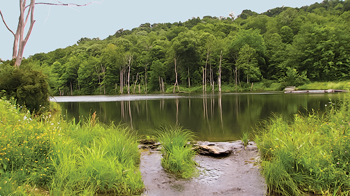 |
| Fig. 3. A large pond below a proposed Marcellus shale gas well pad that supports an abundant, diverse fish population. |
|
NETL’s mobile air monitoring station has already been moved downwind of the site to collect four seasons of background (baseline) environmental data before well construction begins. Monitoring of environmental parameters will continue through well drilling and completion, and for at least one year of well production. By providing a more complete understanding of the impacts of Marcellus shale natural gas production on the local and regional environment, NETL can help ensure that development proceeds at a rate that protects the environment and ensures an adequate domestic supply.
CHEMICAL AND MICROBIOLOGICAL CHARACTERIZATION OF CO-PRODUCED WATER
NETL microbiologists have determined that the microbial ecology of Marcellus shale production water changes significantly with time, as the water is stored in on-site pits and centralized impoundments, Fig.4. Changes in bacterial populations have been linked to the consumption of labile organic compounds, used in hydraulic fracturing (particularly friction reducers), and to the amount of dissolved oxygen. Understanding the complex, ever-changing ecology of this water is important, when the water is to be re-used for additional well completions. Furtherance of this work is expected to lead to more environmentally acceptable biocides, and new methods to manage the adverse impacts of bacteria on shale gas development and production.
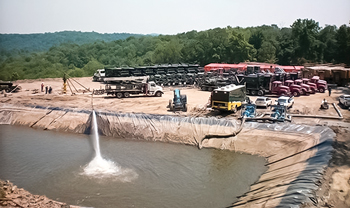 |
| Fig. 4. Lined impoundments provide temporary storage for water needed for hydraulic fracturing, as well as the water that rapidly flows back to the surface, when the well is being prepared for production (photo courtesy of Energy Corp. of America). |
|
Finally, collaboration between researchers at the University of Pittsburgh and NETL has identified a unique isotopic signature for Marcellus shale produced water. This signature can allow the produced water to be distinguished from other sources of contaminated water in western Pennsylvania (e.g. water from coal mines). This methodology, theoretically, should allow researchers to calculate the contribution of Marcellus shale produced water to the overall volume of flowback water from completed gas wells.
OTHER ENVIRONMENTAL ASPECTS
Another NETL study has examined the influence of unpaved roads, built to service the oil and gas industry, in the Allegheny National Forest, on stream sedimentation and ecology. Two adjacent watersheds, similar in size and topography, but having either low or very high road density, were studied. The primary stream in each watershed was instrumented with water flow and quality monitors, and directly monitored via satellite telemetry, in cooperation with the USGS. A rainfall simulation device, provided by Penn State’s Center for Dirt and Gravel Roads, was used to create repeatable, simulated rainfall events. Runoff was collected from 14 different road sites. An average 815 lb of sediment runoff per 0.6 mi of road was measured for the 30-min. rainfall events. Macroinvertebrate populations, indicative of stream health, were collected by personnel from Clarion University of Pennsylvania during the early summer, late summer and fall, from two sites in each watershed. Preliminary data analysis indicates that macroinvertebrate populations in both watersheds appear similar in terms of overall community richness and diversity, despite large differences in sediment runoff. This implies that the greater sediment loads of the oil-and-gas-impacted watershed may be below the threshold needed to impact macroinvertebrate populations adversely. These results can, potentially, be extended to brook trout and some bird species that rely on macroinvertebrates as their primary food. The results also suggest that the presence, or absence, of specific indicator species may be a better indication of road-generated sediment impact than the more costly and time-consuming analysis of the total population.
 |
| Fig. 5. A Cerulean Warbler (a ridge top species) captured, tagged and released in a disturbed portion of the Wetzel Wildlife Management Area, Wetzel Co., WV. |
|
 |
| Fig. 6. A Louisiana Waterthrush (a stream valley-dwelling species) captured, tagged and released in a disturbed portion of the Wetzel Wildlife Management Area, Wetzel Co., WV. |
|
The deciduous forests of the central Appalachians provide habitat for many bird species, including raptors and songbirds. Another NETL study, being carried out by West Virginia University, has established an important baseline of bird population data, in an area that has experienced both historic and current oil and gas activities. In addition, to complete bird population counts, the study focuses on two forest songbirds that are of particular regional conservation concern, the Cerulean Warbler (a ridge top species, Fig. 5.) and the Louisiana Waterthrush (a stream valley-dwelling species, Fig. 6.). The field-intensive research examines the distribution and abundance of these species, relative to energy extraction-related activities in these two habitats. Birds that live at the forest edge have been found to be more abundant in areas disturbed by oil and gas activity, due to forest clearing and road building. Long-term field studies, such as this, are required to fully understand the complex annual variations that occur in natural bird populations, and to develop better management plans that optimize habitat protection and species diversity.

|
The author
ERIC SMISTAD is an Oil and Gas Technology Manager at the Department of Energy’s National Energy Technology Laboratory in Sugar Land, Texas. He has worked for the Department of Energy for approximately 20 years, managing various environmental and technology development projects. He holds a BS degree in Geology from Texas Tech University. |
|









